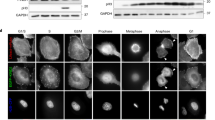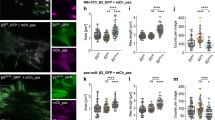Abstract
The Crk II adaptor protein encodes an SH2/SH3-domain containing adaptor protein with an SH2–SH3–SH3 domain structure that transmits signals from tyrosine kinases. The two SH3 domains are separated by a 54 amino acid linker region, whose length is highly conserved in xenopus, chicken, and mamalian Crk II proteins. To gain a better understanding into the role of the C-terminal region of Crk, we generated a series of C-terminal SH3 domain and SH3 linker mutants and examined their role in tyrosine kinase pathways. Expression of point mutations in the C-terminal SH3 domain (W276K Crk), at the tyrosine phosphorylation site (Y222F Crk II), or truncation of the entire C-terminus (Crk I or Crk Δ242), all increased c-Abl binding to the N-terminal SH3 domain of Crk and, where relevant, increased Tyr222 phosphorylation. Deletion analysis of c-Crk II also revealed the presence of a C-terminal segment important for trans-activation of FAK. Such mutants, Crk Δ255 or Crk Δ242 Extended Linker (Crk Δ242[EL]), characterized by a disruption in the SH3 linker/C-terminal SH3 boundary, induced robust hyperphosphorylation of focal adhesion kinase (FAK) on Tyr397, hyperphosphorylation of focal adhesion proteins p130cas and paxillin and increased focal adhesion formation in NIH3T3 cells. The effects of Crk Δ242[EL] could be abrogated by co-expression of dominant negative c-Src or the protein tyrosine phosphatase PTP–PEST, but not by dominant negative Abl. Our results suggest that the C-terminal region of Crk contains negative regulatory elements important for both Abl and FAK dependent signal pathways, and offers a paradigm for an autoinhibitory region in the SH3 linker/C-terminal SH3 domain.
This is a preview of subscription content, access via your institution
Access options
Subscribe to this journal
Receive 50 print issues and online access
$259.00 per year
only $5.18 per issue
Buy this article
- Purchase on Springer Link
- Instant access to full article PDF
Prices may be subject to local taxes which are calculated during checkout






Similar content being viewed by others
References
Altun-Gultekin ZF, Chandriani S, Bougeret C, Ishizaki T, Narumiya S, de Graaf P, Van Bergen en Henegouwen P, Hanafusa H, Wagner JA and Birge RB. . 1998 Mol. Cell. Biol. 18: 3044–3058.
Angers-Loustau A, Cote JF, Charest A, Dowbenko D, Spencer S, Lasky LA and Tremblay ML. . 1999 J. Cell. Biol. 144: 1019–1031.
Barila D and Superti-Furga G. . 1998 Nat. Genet. 18: 280–282.
Birge RB, Fajardo JE, Reichman C, Shoelson SE, Songyang Z, Cantley LC and Hanafusa H. . 1993 Mol. Cell. Biol. 13: 4648–4656.
Birge RB, Knudsen BS, Besser D and Hanafusa H. . 1996 Genes Cells 1: 595–613.
Cheresh DA, Leng J and Klemke RL. . 1999 J. Cell. Biol. 146: 1107–1116.
Cot JF, Turner CE and Tremblay ML. . 1999 J. Biol. Chem. 274: 20550–20560.
Cote JF, Charest A, Wagner J and Tremblay ML. . 1998 Biochemistry 37: 13128–13137.
Dolfi F, Garcia-Guzman M, Ojaniemi M, Nakamura H, Matsuda M and Vuori K. . 1998 Proc. Natl. Acad. Sci. USA 95: 15394–15399.
Escalante M, Courtney J, Chin WG, Teng KK, Kim JI, Fajardo JE, Mayer BJ, Hempstead BL and Birge RB. . 2000 J. Biol. Chem. 275: 24787–24797.
Feller SM, Knudsen B and Hanafusa H. . 1994 EMBO J. 13: 2341–2351.
Feller SM, Posern G, Voss J, Kardinal C, Sakkab D, Zheng J and Knudsen BS. . 1998 J. Cell. Physiol. 177: 535–552.
Galletta BJ, Niu XP, Erickson MR and Abmayr SM. . 1999 Gene 228: 243–252.
Garton AJ, Burnham MR, Bouton AH and Tonks NK. . 1997 Oncogene 15: 877–885.
Garton AJ, Flint AJ and Tonks NK. . 1996 Mol. Cell. Biol. 16: 6408–6418.
Garton AJ and Tonks NK. . 1999 J. Biol. Chem. 274: 3811–3818.
Giancotti FG and Ruoslahti E. . 1999 Science 285: 1028–1032.
Hasegawa H, Kiyokawa E, Tanaka S, Nagashima K, Gotoh N, Shibuya M, Kurata T and Matsuda M. . 1996 Mol. Cell. Biol. 16: 1770–1776.
Hashimoto Y, Katayama H, Kiyokawa E, Ota S, Kurata T, Gotoh N, Otsuka N, Shibata M and Matsuda M. . 1998 J. Biol. Chem. 273: 17186–17191.
Hildebrand JD, Schaller MD and Parsons JT. . 1995 Mol. Biol. Cell. 6: 637–647.
Kiyokawa E, Hashimoto Y, Kobayashi S, Sugimura H, Kurata T and Matsuda M. . 1998a Genes Dev. 12: 3331–3336.
Kiyokawa E, Hashimoto Y, Kurata T, Sugimura H and Matsuda M. . 1998b J. Biol. Chem. 273: 24479–24484.
Kizaka-Kondoh S, Matsuda M and Okayama H. . 1996 Proc. Natl. Acad. Sci. USA 93: 12177–12182.
Knudsen BS, Feller SM and Hanafusa H. . 1994 J. Biol. Chem. 269: 32781–32787.
Ling P, Yao Z, Meyer CF, Wang XS, Oehrl W, Feller SM and Tan TH. . 1999 Mol. Cell. Biol. 19: 1359–1368.
Matsuda M, Hashimoto Y, Muroya K, Hasegawa H, Kurata T, Tanaka S, Nakamura S and Hattori S. . 1994 Mol. Cell. Biol. 14: 5495–5500.
Matsuda M and Kurata T. . 1996 Cell Signal 8: 335–340.
Mayer BJ, Hamaguchi M and Hanafusa H. . 1988 Cold Spring Harb. Symp. Quant. Biol. 53: 907–914.
Mayer BJ, Hirai H and Sakai R. . 1995 Curr. Biol. 5: 296–305.
Mochizuki N, Ohba Y, Kobayashi S, Otsuka N, Graybiel AM, Tanaka S and Matsuda M. . 2000 J. Biol. Chem. 275: 12667–12671.
Nojima Y, Morino N, Mimura T, Hamasaki K, Furuya H, Sakai R, Sato T, Tachibana K, Morimoto C, Yazaki Y, et al. 1995 J. Biol. Chem. 270: 15398–15402.
Ogawa S, Toyoshima H, Kozutsumi H, Hagiwara K, Sakai R, Tanaka T, Hirano N, Mano H, Yazaki Y and Hirai H. . 1994 Oncogene 9: 1669–1678.
Oktay M, Wary KK, Dans M, Birge RB and Giancotti FG. . 1999 J. Cell. Biol. 145: 1461–1469.
Polte TR and Hanks SK. . 1995 Proc. Natl. Acad. Sci. USA 92: 10678–10682.
Reddien PW and Horvitz HR. . 2000 Nat. Cell. Biol. 2: 131–136.
Reichman CT, Mayer BJ, Keshav S and Hanafusa H. . 1992 Cell Growth Differ. 3: 451–460.
Richardson A, Malik RK, Hildebrand JD and Parsons JT. . 1997 Mol. Cell. Biol. 17: 6906–6914.
Rosen MK, Yamazaki T, Gish GD, Kay CM, Pawson T and Kay LE. . 1995 Nature 374: 477–479.
Sakai R, Iwamatsu A, Hirano N, Ogawa S, Tanaka T, Mano H, Yazaki Y and Hirai H. . 1994 EMBO J. 13: 3748–3756.
Schlaepfer DD, Broome MA and Hunter T. . 1997 Mol. Cell. Biol. 17: 1702–1713.
Schlaepfer DD, Hanks SK, Hunter T and van der Geer P. . 1994 Nature 372: 786–791.
Schlaepfer DD and Hunter T. . 1997 J. Biol. Chem. 272: 13189–13195.
Senechal K, Heaney C, Druker B and Sawyers CL. . 1998 Mol. Cell. Biol. 18: 5082–5090.
Shen Y, Schneider G, Cloutier JF, Veillette A and Schaller MD. . 1998 J. Biol. Chem. 273: 6474–6481.
Sicheri F, Moarefi I and Kuriyan J. . 1997 Nature 385: 602–609.
Songyang Z, Shoelson SE, McGlade J, Olivier P, Pawson T, Bustelo XR, Barbacid M, Sabe H, Hanafusa H, Yi T, et al. 1994 Mol. Cell. Biol. 14: 2777–2785.
Tamura M, Gu J, Danen EH, Takino T, Miyamoto S and Yamada KM. . 1999 J. Biol. Chem. 274: 20693–20703.
Tamura M, Gu J, Matsumoto K, Aota S, Parsons R and Yamada KM. . 1998 Science 280: 1614–1617.
Tanaka S and Hanafusa H. . 1998 J. Biol. Chem. 273: 1281–1284.
Tanaka S, Morishita T, Hashimoto Y, Hattori S, Nakamura S, Shibuya M, Matuoka K, Takenawa T, Kurata T, Nagashima K, et al. 1994 Proc. Natl. Acad. Sci. USA 91: 3443–3447.
ten Hoeve J, Morris C, Heisterkamp N and Groffen J. . 1993 Oncogene 8: 2469–2474.
Vuori K and Ruoslahti E. . 1995 J. Biol. Chem. 270: 22259–22262.
Wu X, Knudsen B, Feller SM, Zheng J, Sali A, Cowburn D, Hanafusa H and Kuriyan J. . 1995 Structure 3: 215–226.
Acknowledgements
We would like to thank Tomoyuki Shishido and Hidesaburo Hanafusa for discussing unpublished results, and Jong-Il Kim for helpful discussions. We also thank Paul Kaloudis for his assistance in the digital imaging of the immunofluoresence studies and Jason Ptacek for help in the preparation of figures. This work was supported by Public Health Service Awards to RB Birge (RO1 GM55760) and from a Muscular Dystrophy Association (MDA) grant.
Author information
Authors and Affiliations
Rights and permissions
About this article
Cite this article
Zvara, A., Fajardo, J., Escalante, M. et al. Activation of the focal adhesion kinase signaling pathway by structural alterations in the carboxyl-terminal region of c-Crk II. Oncogene 20, 951–961 (2001). https://doi.org/10.1038/sj.onc.1204173
Received:
Revised:
Accepted:
Published:
Issue Date:
DOI: https://doi.org/10.1038/sj.onc.1204173
Keywords
This article is cited by
-
Vps11 and Vps18 of Vps-C membrane traffic complexes are E3 ubiquitin ligases and fine-tune signalling
Nature Communications (2019)
-
Src inhibition attenuates polyglutamine-mediated neuromuscular degeneration in spinal and bulbar muscular atrophy
Nature Communications (2019)
-
Dephosphorylation of HDAC4 by PP2A-Bδ unravels a new role for the HDAC4/MEF2 axis in myoblast fusion
Cell Death & Disease (2019)
-
Structural basis for regulation of the Crk signaling protein by a proline switch
Nature Chemical Biology (2011)
-
Tuning protein autoinhibition by domain destabilization
Nature Structural & Molecular Biology (2011)



